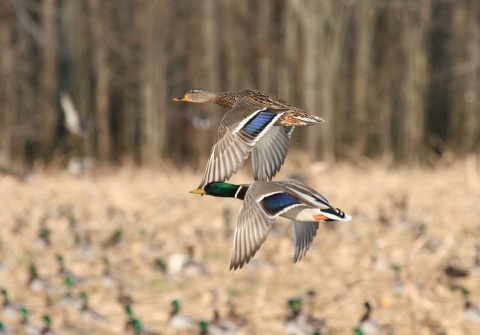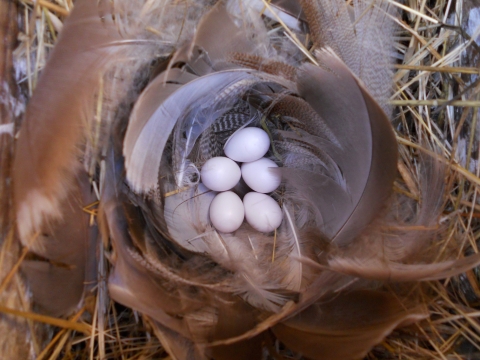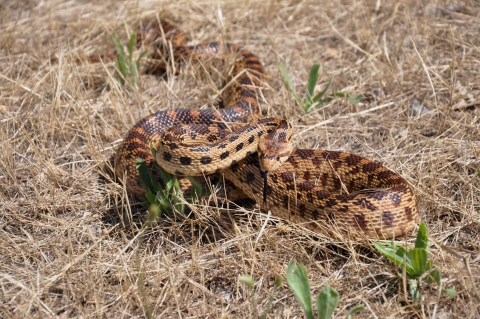Seasons of Wildlife
Winter
Bundle up, as this is the best time of year to view visiting migratory wildlife. Seasonal wetlands, lush green grasslands, and mild climate welcome birds to Stone Lakes NWR from as far as Arctic National Wildlife Refuge in Alaska. These migrants will spend the winter eating and storing up energy for their long flight back to breeding grounds in early spring. Common distant visitors include ducks, geese, Sandhill cranes, sandpipers, and plovers.
Spring
As winter gives way to warmer weather and far visiting migrants head back to distant breeding grounds, many species of wildlife will call the refuge home to raise their young. Seeking safe and secluded spots from predators, you just might be lucky enough to see little ones for American Avocets, Mallards, Tree Swallows, Swainson's Hawks, Great Blue Herons, and even bounding Coyote pups.
Summer
Temperatures are rising and breeding is winding down, time for the wildlife to teach their young survival skills, molt last years feathers or fur, and forage on summer seeds, insects and berries. Seasonal wetlands are dried up, grasslands turn golden yellow, and the riparian riparian
Definition of riparian habitat or riparian areas.
Learn more about riparian tree line offers welcomed relief from the afternoon heat. Snakes are active in search for their next lunch. Morning is best to catch summer songs from Western Kingbirds, Western Meadowlarks, warblers, and wrens.
Fall
As the sun starts sinking and the days grow shorter, brisk mornings will signal another change of seasons for the wildlife. Summers food supply has grown short, and the fall rains germinate remaining seeds to start the cycle over again. Migratory wildlife become restless as they prepare for another long journey to the refuge. As the wetlands are being flooded up in anticipation of our winter visitors, we hear the familiar call of a Sandhill crane....
Featured Species
The diverse habitats of Stone Lakes National Wildlife Refuge are home to over 200 species of birds and numerous other fish and wildlife species. The refuge is located in the heart of California’s Central Valley along the Pacific Flyway. When combined with neighboring natural areas, it is part of a vast landscape corridor that serves as a sanctuary for many resident and migratory fish, wildlife, and plant species.
Just as the refuge manages for native wildlife, another top priority is the protection and restoration of Central Valley native plants. Many native wildlife species are dependent upon these plants for survival, and can be very specific to even just one type of plant, such as the Elderberry Longhorn Beetle.
One of the important functions of National Wildlife Refuges is the protection and conservation of species listed as Endangered, Threatened, or Species of Special Concern. Stone Lakes NWR provides needed habitats for several species that are either found on or suspected to be on refuge managed lands for Federal and/or State of California lists. Stone Lakes NWR is composed of a rich mosaic of habitats that support hundreds of species for both resident and migratory wildlife. The main types of habitat managed by the refuge are grasslands, riparian riparian
Definition of riparian habitat or riparian areas.
Learn more about riparian forest, woodland savanna, freshwater lakes, freshwater sloughs, perennial wetlands, seasonal wetlands, and vernal pools.
Additionally, with such a mild climate and nutrient rich soils, plants, and waterways, invasive plant and wildlife species not native to the Central Valley are taking hold, often times forcing out the desired native species. Countless hours goes into controlling these invasive species invasive species
An invasive species is any plant or animal that has spread or been introduced into a new area where they are, or could, cause harm to the environment, economy, or human, animal, or plant health. Their unwelcome presence can destroy ecosystems and cost millions of dollars.
Learn more about invasive species so we can provide the highest quality habitat for our native wildlife.






